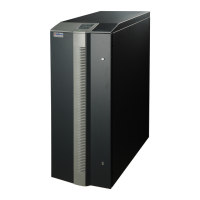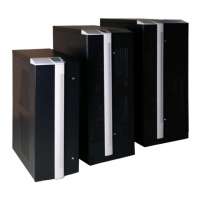Do you have a question about the inform Pyramid Plus and is the answer not in the manual?
Explains the meaning of symbols displayed on the UPS.
Lists essential guidelines for system operation and safety.
Provides critical warnings regarding ventilation, environment, and fuse replacement.
Highlights cautions for authorized personnel and potential electrical hazards.
Specific warnings and precautions related to battery installation, disposal, and risks.
Provides instructions for safely moving and transporting UPS units.
Introduces installation, emphasizes authorized personnel, and warns about power application.
Guides the user through the process of unpacking the UPS unit.
Details recommended placement for the UPS, considering ventilation and environment.
Details the process and specifications for connecting power cables to the UPS.
Explains the critical procedure for connecting the safety earth cable.
Illustrates power cable connections for 10-30 kVA UPS models.
Continues with the step-by-step instructions for connecting power cables.
Illustrates power cable connections for 40-80 kVA UPS models.
Illustrates power cable connections for 100-200 kVA UPS models.
Provides detailed instructions for installing the UPS batteries.
Illustrates battery group connections and wiring.
Illustrates optional battery circuit breaker connections.
Explains how to connect the UPS for communication with a PC or server.
Introduces the UPS front panel features, display, and function keys.
Describes the front panel components, status lamps, and function keys.
Lists and explains various UPS alarms and their possible causes for troubleshooting.
Continues the list of alarms, troubleshooting steps, and status messages.
Explains various status messages and system shutdown notifications.
Explains how to navigate and use the UPS menu system.
Lists available menu items and their corresponding functions for system configuration.
Details the main menu structure and navigation using the DOWN key.
Lists the measured values available for monitoring in the Measures submenu.
Describes how to view recorded log events and valid alarms in the Alarms menu.
Provides information on UPS synchronization, power rating, and version.
Outlines options for configuring UPS operation modes, remote access, and restart.
Details commands for controlling UPS functions like sound alerts, battery tests, and simulation.
Explains how to view and adjust the UPS's date and time settings.
Describes the password-protected menu for system adjustments and service.
Detailed steps for powering on the UPS units in the 10-30kVA range.
Detailed steps for powering on the UPS units in the 40-200kVA range.
Instructions for transferring the load to maintenance bypass for 10-30kVA models.
Instructions for transferring the load to maintenance bypass for 40-200kVA models.
Steps to return from maintenance bypass to inverter mode for 10-30kVA units.
Steps to return from maintenance bypass to inverter mode for 40-200kVA units.
Instructions for transferring the load from static bypass back to inverter mode.
Steps for safely shutting down UPS units in the 10-30kVA range.
Steps for safely shutting down UPS units in the 40-200kVA range.
How the UPS behaves during utility power interruption and battery low conditions.
Explains the purpose of connecting PYRAMID-PLUS systems in parallel.
Outlines the three primary modes for parallel UPS operation.
Describes the symmetric mode for increasing power capacity with load sharing.
Details the redundant mode where one UPS failure does not affect load supply.
Explains the hot standby mode where one UPS remains in reserve.
Lists fault codes specific to parallel operation and their meanings.
Lists necessary accessories for setting up a parallel UPS system.
Step-by-step guide for starting up UPS units in a parallel configuration.
Procedures for transferring parallel UPS operation to maintenance bypass.
Steps to transition from maintenance bypass back to inverter mode in parallel setup.
Details on using the serial link for UPS monitoring and control commands.
Pinout and specifications for the RS232 communication cable.
Explains how to set up remote monitoring and control via modem.
Lists the hardware requirements for modem-based UPS control.
Specifies the cable for connecting a dumb modem to the UPS.
Details connections for monitoring important events via dry contacts.
Information on using remote monitoring panels for UPS status.
Provides suggestions for routine maintenance to maximize UPS lifetime.
Guidelines for storing the UPS and batteries, including temperature recommendations.
Outlines the terms and conditions of the product warranty.

